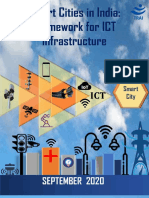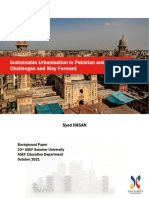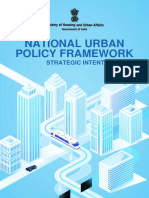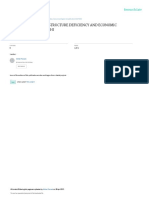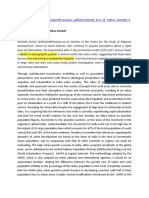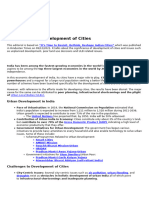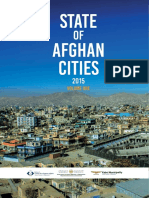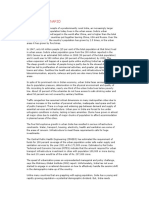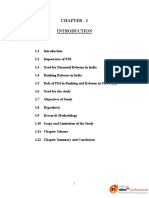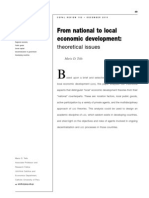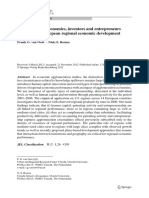0 ratings0% found this document useful (0 votes)
13 viewsAddressing Urbanization Challenges
Addressing Urbanization Challenges
Uploaded by
Darmon MumtazAddressing-Urbanization-Challenges
Copyright:
© All Rights Reserved
Available Formats
Download as PDF, TXT or read online from Scribd
Addressing Urbanization Challenges
Addressing Urbanization Challenges
Uploaded by
Darmon Mumtaz0 ratings0% found this document useful (0 votes)
13 views4 pagesAddressing-Urbanization-Challenges
Original Title
Addressing-Urbanization-Challenges
Copyright
© © All Rights Reserved
Available Formats
PDF, TXT or read online from Scribd
Share this document
Did you find this document useful?
Is this content inappropriate?
Addressing-Urbanization-Challenges
Copyright:
© All Rights Reserved
Available Formats
Download as PDF, TXT or read online from Scribd
Download as pdf or txt
0 ratings0% found this document useful (0 votes)
13 views4 pagesAddressing Urbanization Challenges
Addressing Urbanization Challenges
Uploaded by
Darmon MumtazAddressing-Urbanization-Challenges
Copyright:
© All Rights Reserved
Available Formats
Download as PDF, TXT or read online from Scribd
Download as pdf or txt
You are on page 1of 4
cdpr
Policy Brief PB1502 Cities March 2015
Addressing Urbanization
admin@cdpr.org.pk
Challenges
+924235778180
About the project This policy brief has been written by Shehryar Nabi, that is
www.cdpr.org.pk.
based on research by Umair Javed (LUMS, CDPR), Dr.
Funded by: DFID Husnain Fateh (LUMS) and Sohaib Athar (IGC). Overall
guidance was provided by Dr. Ijaz Nabi (CDPR).
Key Counterpart: DFID
Impact: Provided a Political
Economy Analysis (PEA) on
urban development with a list
of opening interventions for
urban development (with
private sector development).
In brief
Ÿ The cost-reducing mechanism that makes cities
attractive centers of industry and commerce is known as
the “agglomeration effect”.
Ÿ Pakistan has South Asia's highest proportion of urban
residents.
Ÿ Challenges to successful urbanization include
suboptimal opportunities for employment and housing
and inadequate transportation facilities.
Urbanization and Economic Growth in Pakistan country’s GDP. While, in Indonesia, 44 percent of
the population lives in cities and contributes
The trajectories of rapidly developing countries more than 60 percent of GDP.
suggest that urbanization and economic growth
come in a package. Brazil, with an urban Figure 1: Manufacturing Employment in Pakistan
population of 84 percent in 2010, has
experienced many episodes of rapid economic
growth. In the same year, almost half of fast
growing China’s population lived in cities, an
increase of more than 20 percent since 1991.
The cost-reducing mechanism that makes cities
attractive centers of industry and commerce is
known as the “agglomeration effect”. Firms,
workers and financiers living in close proximity in
cities help lower the cost of production.
Agglomeration is important for economic
growth because it facilitates the growth of new
firms thus encouraging entrepreneurship and
new ideas.
Pakistan has South Asia’s highest proportion of
urban residents. By 2030, an expected 50
percent of Pakistanis will live in cities, up from the
current 40 percent. Pakistani cities contribute 55
percent of the country’s total GDP spanning
manufacturing, retail, wholesale trade,
construction and transport. Pakistani cities are expanding without sufficient
planning, leading to poor infrastructure,
Urbanization in Pakistan occurs largely through inefficient public services and unaffordable
migration from low-income rural areas. Most of housing. This has prevented the realization of
the migration occurs within provinces. In 2011, agglomeration benefits in terms of lower
movement inside provinces accounted for 80 production costs, growth of entrepreneurship
percent of urban migration in Punjab, 58 and creation of much needed jobs. Without a
percent in Baluchistan and 56 percent in both sound policy for urban development, Pakistan is
Sindh and Khyber Pakhtunkhwa (KPK). Inter-city being denied the full economic and social
migration is a rising trend in Baluchistan and advantages cities offer.
Sindh, while rural to urban migration continues to
be the pre-eminent method of urbanization in Challenges to Successful Urbanization
Punjab and KPK.
Urban Employment
Migration to cities from politically unstable
regions has contributed significantly to Only 40 percent of urban residents participate in
Pakistan’s urban population over the last 30 the labor force, and women are
years. Almost 5 million people moved to cities to disproportionately underrepresented at 10
escape multiple conflicts in Afghanistan and percent. The overall unemployment rate is
Pakistan’s military campaign in KPK and the almost 9 percent. With 65 percent of citizens
Federally Administered Tribal Areas (FATA). under the age of thirty, Pakistan has a large
“youth bulge” This requires nearly one million
Agglomeration in Punjab particularly has additional jobs every year for fresh entrants into
unfolded along the lines predicted by theory. It is the labor market. Cities are currently not
more evident in the form of localization positioned to meet this challenge. If cities
economies, in which benefits are received due continue to operate with low levels of
to interactions within industries and the sharing employment and poor service delivery, a class
of inputs. Hubs of economic activity have of disaffected youth could emerge as a
proliferated around cities within the Lahore- precursor to political and social strife.
Faisalabad-Sialkot-Gujranwala corridor, and
urban areas in Punjab contribute 25 to 33 Transportation
percent of Pakistan’s total GDP (Figure 1).
Low use of public transport and increasing
Given Pakistan’s level of urbanization, the private vehicle ownership has worsened traffic in
economy could be performing much better. Pakistani cities, increased congestion and raised
India has 30 percent of the total population production costs. The volume of traffic is
living in cities, which provides 58 percent of the increasing nationally by 8 percent every year.
Even in the most developed cities such as inadequate sanitation costs Pakistan nearly 4
Karachi and Lahore, only 23 percentand 16 percent of its GDP.
percent of trips respectively are made on public
transport. Without sufficient investment in public Manufacturing activity
Transport to accommodate urban expansion,
the stress on existing transport infrastructure will Urban job creation requires rapid growth in
intensify. manufacturing activity that creates sustained
demand for workers across a range of skills. It is
Inadequate public transport also adds to the not encouraging that the share of
existing problem of unemployment in Pakistani manufacturing in GDP has stagnated as have
cities, because it makes centers of employment manufactured exports. Poor urban services are
harder to access for labor. partly to blame for this. The disincentives to
investment in long gestation manufacturing
Housing projects also stem from exchange rate, trade,
fiscal and energy pricing policies that would
Demand for urban housing is exceeding what need to be revisited.
both the private and public sectors have been
able to provide. In 2014, there was a shortage of Recent Developments
10 million homes, mostly reflecting the low-
income market. An estimated 47 percent of the Urban policy is becoming increasingly visible in
country’s urban population lives in squatter the national development agenda. The role of
settlements, where low-income residents pay cities as drivers of high growth was central to the
high premiums to live in what are often squalid Planning Commission of Pakistan’s New
conditions. This is illustrated by the fact that in Framework for Economic Growth, formulated in
Karachi, rent prices in relation to median income 2011. The current government has continued to
are high by international standards (see Table 1). emphasize the importance of urbanization. Its
The problem is even bigger in the five largest Vision 2025 strategy cites legal reform for zoning,
cities in Pakistan, which are predicted to commercialization, taxation and improved
account for 78 percent of the total housing urban infrastructure as the foundation for high-
shortage by 2035, if current trends continue. growth urbanization. The Punjab Growth
Strategy 2018 also supports dense urban centers
Table 1: Comparison of Home Ownership and to attract investment and boost productivity.
Rental Cost
An early sign of policy put into action in Punjab
was the government’s establishment of the Bus
Rapid Transit (BRT) Line in Lahore. An average of
150,000 passengers ride the transit line every
day. Another BRT line has been established in
Islamabad and Rawalpindi, and more are being
planned for Faisalabad, Multan and Lahore. The
BRT has made job centers more accessible to
labour, and in turn has increased the pool of
labour available to employers.
Lahore in particular has seen efforts to improve
municipal delivery of services through the
establishment of the Lahore Waste
Management Company, the Lahore Transport
Company and the Lahore Parking Company.
Establishment of similar companies is also
planned in other large cities in Punjab.
To enhance revenue generation, the Punjab
government is digitally mapping cities for a more
precise tax assessment. It is also working with
Water and Sanitation economists from Harvard University, the
Massachusetts Institute of Technology and the
Water is supplied for only 4 to 16 hours a day in International Growth Centre to incentivize
most cities. Untreated wastewater deposits property tax inspectors. The establishment of the
chemicals into natural bodies of water. Poor Punjab Revenue Authority has increased
municipal service delivery has undermined the collection of sales tax on services.
quality of sanitation in urban areas. Solid waste is
often placed in low-quality dumps and Recent events have also demonstrated the
waterways. The World Bank estimates that increasing political importance of cities.
The emergence of the Pakistan Tehreek-e-Insaaf ownership rights of multiple residents. Officially
(PTI), as the second largest political party in recognize and provide secure tenure to informal
Punjab, sprung from the province’s urban urban settlements and improve the services; this
centers. This has promoted political competition will increase collateral value of houses for
between PML (N) and PTI, and increased financial transactions.
urgency to respond to the demand for better
public services and job creation. Improve management of state land. Release
unproductive state land for better uses, such as
Proposed Interventions low-income housing, commercial
development, office buildings, recreational
Governance reform spaces and community centers.
Strengthen local government: Low-tiered Industrial Development
government bodies can deliver local services
more effectively than centralized Adopt a comprehensive strategy for sustained
administrations. Transfer authority of specialized industrialization and productive urban jobs.
agencies in areas such as waste management, Allocate land to promote industry. Rezone
sanitation and transport from provincial industrial areas so that industrial expansion can
governments to local governments. occur without procedural impediments.
Additionally, establish industrial estates with fully
Facilitate provision of services within and across equipped facilities (water, sanitation, waste
jurisdictions. Update city boundaries to water treatment, power and security).
accurately define jurisdictions. Set up central
coordinating committees of service delivery Adopt regional planning. Organizing at the
agencies to respond to the newly defined regional level will integrate housing, education
jurisdictions. and commercial development with transport
networks and will promote broad-based,
Introduce staff trainings, better performance balanced growth.
incentives and modern technologies. Together,
these actions will improve the functioning of Transportation
smaller cities and towns.
Bolster public transport by bus. Invest in Rapid
Commercialization, Private Sector Investment, Bus Transit routes with both public and private
and Affordable Housing funding in all major cities and incentivize the
private sector to increase the number of
Promote vibrant land markets. Modernize land available buses in Pakistani cities.
recording systems to reduce the costs of
property registration and reduce processing Revenue reform
times and fees to convert residential areas into
commercial areas. Improve property tax collection. Update
valuation tables regularly, lower high tax
Increase access to housing through better Land differentials between owner-occupied and
management. Promote a Mixed Land Use rental property.
classification in zoning and highly dense
transportation nodes to increase the access of Dynamic tax policy. While designing tax on
rental housing for lower income residents. services, strike the right balance between the
Promote the principles of multiple ownership objectives of increased tax collection and
and condominium development to secure the incentivizing firm growth.
You might also like
- 14 IoT Case Study AssignmentDocument134 pages14 IoT Case Study AssignmentWolfskinNo ratings yet
- Background Paper - Sustainable Urbanisation in PakistanDocument16 pagesBackground Paper - Sustainable Urbanisation in PakistanHawaid AhmadNo ratings yet
- Urbanization in Pakistan: Ishrat HusainDocument9 pagesUrbanization in Pakistan: Ishrat HusainRubabNo ratings yet
- Urbanization in PakistanDocument9 pagesUrbanization in PakistanMuhammad AteeqNo ratings yet
- Urbanization in PakistanDocument11 pagesUrbanization in PakistanBin AwaisNo ratings yet
- Reimagining Pakistan'S Cities: Making Cities More CompetitiveDocument21 pagesReimagining Pakistan'S Cities: Making Cities More CompetitiveSyed Zaki Ali AsgharNo ratings yet
- Development Economics: Topic: Urbanization in Pakistan With Respect To ChinaDocument5 pagesDevelopment Economics: Topic: Urbanization in Pakistan With Respect To ChinaMishal iqbalNo ratings yet
- Urbanization in Pakistan: A Governance Perspective: Monument, Decentralization, Human DevelopmentDocument10 pagesUrbanization in Pakistan: A Governance Perspective: Monument, Decentralization, Human DevelopmentSehrish ChNo ratings yet
- Mass Rapid Transportation Systems in IndiaDocument22 pagesMass Rapid Transportation Systems in IndiaSKNo ratings yet
- LAM SafalVerma UrbanizationDocument8 pagesLAM SafalVerma UrbanizationSafal VermaNo ratings yet
- PIDE Knowledge Brief 13Document27 pagesPIDE Knowledge Brief 13Noman KhanNo ratings yet
- Urbanization in Pakistan PDFDocument7 pagesUrbanization in Pakistan PDFWaqas HabibNo ratings yet
- Research Report (FINAL)Document5 pagesResearch Report (FINAL)ridaNo ratings yet
- NUPF - Final - Oct 2020Document32 pagesNUPF - Final - Oct 2020Kavyanjali SinghNo ratings yet
- Whither Urban Renewal?: ErspectivesDocument6 pagesWhither Urban Renewal?: ErspectivesSaurabh SumanNo ratings yet
- Urban Sprawl, Infrastructure Deficiency and Economic Inequalities in KarachiDocument9 pagesUrban Sprawl, Infrastructure Deficiency and Economic Inequalities in KarachiAkhtar RashidNo ratings yet
- Punhab 2Document25 pagesPunhab 2Sunil SuniNo ratings yet
- Private Sector Participation in The Transport Sector in IndiaDocument18 pagesPrivate Sector Participation in The Transport Sector in Indianaresh1No ratings yet
- Assessing The Impact of A Micro-Finance Programme: Orangi Pilot Project, Karachi, PakistanDocument25 pagesAssessing The Impact of A Micro-Finance Programme: Orangi Pilot Project, Karachi, PakistanAbhipsa MallickNo ratings yet
- Promoting Entrepreneurship, Employment and Skilling - Leveraging The Demographic DividendDocument8 pagesPromoting Entrepreneurship, Employment and Skilling - Leveraging The Demographic DividendAmitNo ratings yet
- Urbanisation and Industrialisation in Asian Countries The Spectre of Premature DeindustrialisationDocument19 pagesUrbanisation and Industrialisation in Asian Countries The Spectre of Premature Deindustrialisationpescones48No ratings yet
- Inclusive Growth: Reclaiming Prosperity in Khyber-Pakhtunkhwa - A Medium Term Strategy ForDocument6 pagesInclusive Growth: Reclaiming Prosperity in Khyber-Pakhtunkhwa - A Medium Term Strategy FornasirahmadNo ratings yet
- Planning For Urban Infrastructure: January 2006Document24 pagesPlanning For Urban Infrastructure: January 2006KianuNo ratings yet
- IndiaDocument12 pagesIndia25-A-Sujal LunawatNo ratings yet
- Integrated TownshipDocument6 pagesIntegrated TownshipvigneshNo ratings yet
- Urbanization and Economic Development of Bangladesh: The Primacy of Dhaka and CompetitivenessDocument21 pagesUrbanization and Economic Development of Bangladesh: The Primacy of Dhaka and CompetitivenessnamelessNo ratings yet
- 4 PDFDocument21 pages4 PDFAaron LeonardNo ratings yet
- India Urban Infrastructure Report 2020: ResearchDocument87 pagesIndia Urban Infrastructure Report 2020: ResearchgeetNo ratings yet
- Politics and Economics of Urban GrowthDocument5 pagesPolitics and Economics of Urban GrowthVinoth KumarNo ratings yet
- Mod CEOG Executive Summary 18052022Document19 pagesMod CEOG Executive Summary 18052022Arumugham .kNo ratings yet
- An Approach To Regional Planning in India PDFDocument6 pagesAn Approach To Regional Planning in India PDFAshique V.VNo ratings yet
- Padam SinghDocument28 pagesPadam SinghSimran KashyapNo ratings yet
- Urban Planning 1Document3 pagesUrban Planning 1Shraddha RamrajNo ratings yet
- White - Paper - 2smart Citiws ICTDocument134 pagesWhite - Paper - 2smart Citiws ICTAshish SachdevNo ratings yet
- Municipal Performance IndexDocument86 pagesMunicipal Performance IndexKumarSubhamNo ratings yet
- "Pakistani Cities in 2030": Rasheed Ahmed Shah RashdiDocument4 pages"Pakistani Cities in 2030": Rasheed Ahmed Shah RashdiAsif Khan ShinwariNo ratings yet
- Urban Infrastructure in India: Present ScenarioDocument6 pagesUrban Infrastructure in India: Present Scenariokanad kumbharNo ratings yet
- Task Force Report On Urban Development: Government of PakistanDocument36 pagesTask Force Report On Urban Development: Government of PakistanMadiha SalamNo ratings yet
- Resource Doc 1663752740 Urban Outcomes Framework Part1 Latest CompressedDocument190 pagesResource Doc 1663752740 Urban Outcomes Framework Part1 Latest Compressedrajiv guptaNo ratings yet
- Overview of Pakistan's Economy - Articles - Embassy of The Islamic Republic of Pakistan BeijingDocument5 pagesOverview of Pakistan's Economy - Articles - Embassy of The Islamic Republic of Pakistan Beijingawahid1990No ratings yet
- Tor Nuds IngDocument23 pagesTor Nuds Ingreno23zoeldyckNo ratings yet
- Mass Rapid Transportation Systems in India: Background PaperDocument22 pagesMass Rapid Transportation Systems in India: Background PaperM PLAN 1719 SAPNo ratings yet
- 2.smart City PuneDocument46 pages2.smart City PuneKale100% (2)
- An Assessment of Pakistan's Urban Policies, 1947-1997Document24 pagesAn Assessment of Pakistan's Urban Policies, 1947-1997Rehmat AlamNo ratings yet
- Smart CitiesDocument24 pagesSmart Citiesuk4950430No ratings yet
- a-study-on-fiscal-policies-to-promote-the-development-of-digital-economy-a-chinese-case-study-228Document14 pagesa-study-on-fiscal-policies-to-promote-the-development-of-digital-economy-a-chinese-case-study-228hNo ratings yet
- GetanehDocument12 pagesGetanehOlivia FantyNo ratings yet
- Task Force Report On Urban Development: Government of PakistanDocument34 pagesTask Force Report On Urban Development: Government of Pakistansyed aamir shahNo ratings yet
- State of Afghan Cities 2015 Volume - 1Document156 pagesState of Afghan Cities 2015 Volume - 1United Nations Human Settlements Programme (UN-HABITAT)No ratings yet
- Urban Challenges and Informal Public Transport Services in NigeriaDocument13 pagesUrban Challenges and Informal Public Transport Services in NigeriaThomas Aghogho OrhadahweNo ratings yet
- India'S Urban ScenarioDocument20 pagesIndia'S Urban ScenarioMd Imran SheikhNo ratings yet
- By409262 Assignment-1 9368: QNO.1 Ans One Major Reason For This Unplanned and Unmanaged Urbanization IsDocument15 pagesBy409262 Assignment-1 9368: QNO.1 Ans One Major Reason For This Unplanned and Unmanaged Urbanization Isasadrind735No ratings yet
- Exploration of Urbanization in PakistanDocument8 pagesExploration of Urbanization in PakistanCharles Kyalo NyamaiNo ratings yet
- Case Study - Rural Migration and Urbanization in Developing Countries PDFDocument9 pagesCase Study - Rural Migration and Urbanization in Developing Countries PDFBernadethNo ratings yet
- Annual Survey of Insia's City Systems 2023Document116 pagesAnnual Survey of Insia's City Systems 2023RaghuNo ratings yet
- OECD (2014) Regional, Rural and Urban DevelopmentDocument2 pagesOECD (2014) Regional, Rural and Urban Developmentrnjn mhta.No ratings yet
- Economy (Mains) Need For Urban Transformation Amid Rapid UrbanisationDocument7 pagesEconomy (Mains) Need For Urban Transformation Amid Rapid Urbanisationavadhojhaclasses01No ratings yet
- Harnessing Uzbekistan’s Potential of Urbanization: National Urban AssessmentFrom EverandHarnessing Uzbekistan’s Potential of Urbanization: National Urban AssessmentNo ratings yet
- Urban Growth and Spatial Transition in Nepal: An Initial AssessmentFrom EverandUrban Growth and Spatial Transition in Nepal: An Initial AssessmentNo ratings yet
- Growth Pole Model of PerrouxDocument5 pagesGrowth Pole Model of PerrouxCharu Sharma0% (1)
- 08 Chapter 1 PDFDocument39 pages08 Chapter 1 PDFKartik PathaniaNo ratings yet
- Growth Centres and Regional Development: Aspects of Theory and PolicyDocument18 pagesGrowth Centres and Regional Development: Aspects of Theory and PolicyalbertodarochaNo ratings yet
- Tourism Destination The Networking ApproachDocument13 pagesTourism Destination The Networking ApproachPrabhaNo ratings yet
- Is Labor Pooling Foundation For Agglomeration?: Applied Economics Research CentreDocument49 pagesIs Labor Pooling Foundation For Agglomeration?: Applied Economics Research CentreAlmasNo ratings yet
- Econ Dev 7.2Document1 pageEcon Dev 7.2Arnel MangilimanNo ratings yet
- Chinese MRKTDocument22 pagesChinese MRKTAnkita SharmaNo ratings yet
- EcoGeo TDocument15 pagesEcoGeo TKhaled KhanNo ratings yet
- Ens 121Document6 pagesEns 121ibrahimmuhammadauwalu04No ratings yet
- Godana Assignment Article 6Document13 pagesGodana Assignment Article 6Godana HukaNo ratings yet
- An Overview of The Key Theories of Foreign Direct Investment: The Way ForwardDocument10 pagesAn Overview of The Key Theories of Foreign Direct Investment: The Way ForwardGAYATRI AGGARWALNo ratings yet
- Urban Economics 9th International Student Edition ISE Arthur O'Sullivan download pdfDocument81 pagesUrban Economics 9th International Student Edition ISE Arthur O'Sullivan download pdfcarravucickp100% (2)
- Dixon - Thirlwall - Cumulative Causation ModelDocument13 pagesDixon - Thirlwall - Cumulative Causation Modelvali75No ratings yet
- International Journal of Production Economics: Tarun Jain, Jishnu HazraDocument12 pagesInternational Journal of Production Economics: Tarun Jain, Jishnu HazraRoshanNo ratings yet
- Fullset - Regional Planning Models - Revised - Mar2019Document111 pagesFullset - Regional Planning Models - Revised - Mar2019Syimir SyahmiNo ratings yet
- Analysis of Tenant Mix in Shoping MallsDocument74 pagesAnalysis of Tenant Mix in Shoping MallsImtsal KhalidNo ratings yet
- Bid2013 Urban EconomicsDocument7 pagesBid2013 Urban Economics23004245No ratings yet
- Duranton Puga JEP 2020Document24 pagesDuranton Puga JEP 2020ClasesNo ratings yet
- Chapter 01 The International Economy and GlobalizationDocument52 pagesChapter 01 The International Economy and GlobalizationtahaNo ratings yet
- From National To Local Economic Development:: Theoretical IssuesDocument17 pagesFrom National To Local Economic Development:: Theoretical IssuesEmine TahsinNo ratings yet
- DissertationDocument314 pagesDissertationkayot96089No ratings yet
- Schilling 6e IPPTChap002 AccessibleDocument26 pagesSchilling 6e IPPTChap002 AccessibleAta Deniz BişenNo ratings yet
- Migration and Urbanization PDFDocument12 pagesMigration and Urbanization PDFArnel MangilimanNo ratings yet
- Ecosistemas de InnovacionDocument13 pagesEcosistemas de InnovacionColibrí 26No ratings yet
- (Ebook PDF) Urban Economics 9th Edition by Arthur O'Sullivan All Chapters Instant DownloadDocument41 pages(Ebook PDF) Urban Economics 9th Edition by Arthur O'Sullivan All Chapters Instant Downloadadisorkoplak100% (5)
- INDUSTRIALDocument1 pageINDUSTRIALPotencia LokoshaNo ratings yet
- Asfachew EditedDocument30 pagesAsfachew EditedTatasha Takaye Kasito100% (1)
- Van Oort & Bosma Aglomeration Economies, Inventor and EntrepreneursDocument33 pagesVan Oort & Bosma Aglomeration Economies, Inventor and EntrepreneursLautaroNo ratings yet
- Regional Advantage Culture and Competition in Silicon Valley and Route 128 (AnnaLee Saxenian)Document241 pagesRegional Advantage Culture and Competition in Silicon Valley and Route 128 (AnnaLee Saxenian)Catalina AnguitaNo ratings yet
- Alfred Weber's Least-Cost ModelDocument6 pagesAlfred Weber's Least-Cost ModelFarzana MirNo ratings yet
